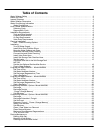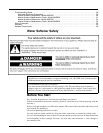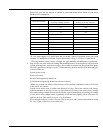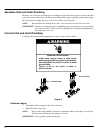
8
Ferric (redwater) , andbacterial and organically bound irons are insoluble. Thiswa ter softener will
not remove ferric or bacterial iron. This iron is visible immediately when draw n from a faucet
because it has oxidized before reaching the home. It appears as small cloudy yellow, orange, or
reddish suspended particles. After the water stands for a period of time, the particles settle to the
bottom of the container. Generally these irons are removed from water by filtration. Chlorination
is also recommended for bacterial iron.
Colloidal and inorganically bound iron is of ferric or ferrous form that will not filter or exchange
out of water. This water softener will not remove colloidal iron. In some instances, treatment may
improve colloidal iron water. Colloidal iron water usually has a yellow appearance when drawn.
After standing for several hours, the color persists and the iron does not settle, but remains
suspended in the water.
3. Acidity or acid water is caused by carbon dioxide and hydrogen sulfide. This wate r softener will
not improve an acid condition in water. Acid water can be corrosive to plumbing, plumbing
fixtures, water heaters, andother water using appliances. In canalso damageand cause premature
failure of seals, diaphrag ms, etc., in water handling equipment.
A chemical analysis is needed to measure the degree of acidity in water. This is called the pH of
water. Water testing below 6.9 pH is acidic. The lower the pH reading, the greater the acidity. A
neutralizer filter or a chemical feed pump are usually recommended to treat acid water.
4. Sediment is fine, foreign material particles suspended in water. This wa ter softener will not
remove sediment. This material is most often clay or silt. Extreme amounts of sediment may give
the water a cloudy appearance. A sediment filter installed ahead of the water softener normally
corrects this situation.
Installation Requirements
Tools and Parts Needed
Assemble the required tools before starting installation.Read andfollow the instructions provided with
any tools listed here.
• Screwdriver • Tape Me asure
• Pliers
If using Soldered Copper Pipe
• Tubing cutter • Lead--free solder and flux
• Propane torch • Emery cloth, sandpa per or steel wool
• Misc. copper pipe fittings
If using Threaded Pipe
• Pipe cutter or hacksaw • Pipe joint compound
• Threading tool • Misc. threaded pipe fittings
If using CPVC Plastic
• Pipe cutter • Solvent cement
• Hacksaw • Primer
• Adjustable wrench • Misc. CPVC pipe fittings
If using Other
• Other pipe and fittings suitable for potable water supply as required by piping system
manufacturer and local codes and/or ordinances.


















